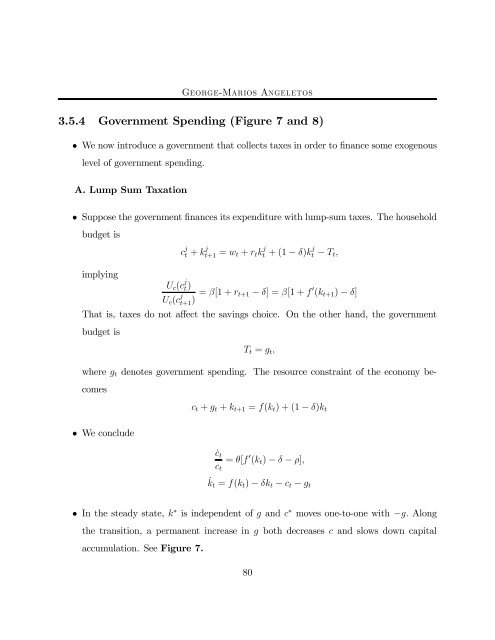14.451 Lecture Notes Economic Growth
14.451 Lecture Notes Economic Growth
14.451 Lecture Notes Economic Growth
Create successful ePaper yourself
Turn your PDF publications into a flip-book with our unique Google optimized e-Paper software.
George-Marios Angeletos<br />
3.5.4 Government Spending (Figure 7 and 8)<br />
• We now introduce a government that collects taxes in order to finance some exogenous<br />
level of government spending.<br />
A. Lump Sum Taxation<br />
• Suppose the government finances its expenditure with lump-sum taxes. The household<br />
budget is<br />
c j<br />
t + k j<br />
t+1 = wt + rtk j<br />
t +(1− δ)k j<br />
t − Tt,<br />
implying<br />
Uc(c j<br />
t)<br />
Uc(c j<br />
t+1) = β[1 + rt+1 − δ] =β[1 + f 0 (kt+1) − δ]<br />
That is, taxes do not affect the savings choice. On the other hand, the government<br />
budget is<br />
Tt = gt,<br />
where gt denotes government spending. The resource constraint of the economy be-<br />
comes<br />
• We conclude<br />
ct + gt + kt+1 = f(kt)+(1− δ)kt<br />
˙ct<br />
ct<br />
= θ[f 0 (kt) − δ − ρ],<br />
˙kt = f(kt) − δkt − ct − gt<br />
• In the steady state, k ∗ is independent of g and c ∗ moves one-to-one with −g. Along<br />
the transition, a permanent increase in g both decreases c and slows down capital<br />
accumulation. See Figure 7.<br />
80

















